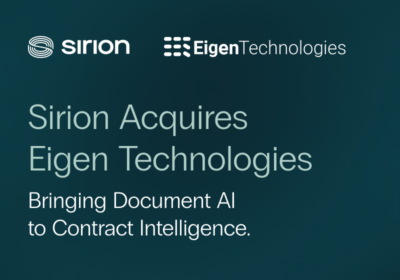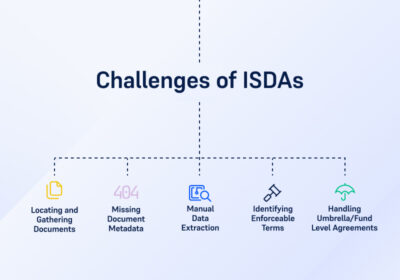The Case for Intelligent Contract Lifecycle Management
By Mahesh Santhanam – Principal Product Manager at Eigen Technologies
The increased demand to manage the complex web of contracts and stakeholders that define your business, and its relationships has driven an explosion in Contract Lifecycle Management (CLM) providers entering the market. Today’s vendors offer compelling technology solutions to solve for collaboration and workflow but fail to solve the fundamental purpose of a CLM: understanding the obligations and risks the organization has entered as a contract is getting negotiated.
We believe that without the ability to identify and risk score every provision of all your incoming and outgoing contracts, you’ve bought a very expensive workflow tool, and not an intelligent CLM solution that enables transformation, operational efficiencies and improved customer delight. It is estimated that you can save approximately 9.5% of annual revenue per year when you have an intelligent CLM. In my own previous experience, an intelligent CLM can introduce anywhere between a 32%–45% reduction in cycle times from negotiation to contract approval. Regulated industries spend millions of dollars in remediation that could have been saved if they had an intelligent CLM in play during negotiation and approvals.
The problem CLMs are meant to solve
Contracts are pivotal in every organization regardless of their size, as they define the terms of engagement between different entities as they engage in a business relationship. Even the simplest and well-understood contract types involve fairly complex, human review intensive manual contracting processes. As the size of the organization grows there is a linear relationship to the number of stakeholders that need to review, approve, and sign contracts and quickly becomes exponential when it comes to the workflow complexity during negotiations.
Digitally transforming enterprise contract management lifecycle (CLM) requires careful orchestration of capabilities that can support the various business functions that need to create and manage templates and clause libraries, author contract drafts, ingest third party contracts, negotiate, risk analyze, e-sign, search and manage and analyze contracts post-execution. At a very fundamental level, you need a platform that can solve not only for workflows and document collaboration, but also one that delivers intelligent clause comparisons, inline risk scoring of contracts, and provides a contract repository with the right level of metadata to support search and analysis. It’s not enough to only seek to understand provisions post-execution. At this point, it is too late to fix or mitigate. Smart enterprises recognize the need to bring intelligence into play earlier and more upfront in the process, to spot and manage risks as they emerge in contract formation.
The Solution Orchestration Challenge
Until very recently CLM vendors were primarily focused on workflows and document collaboration with some metadata extraction capabilities. Enterprises often had to rely on their internal technology teams to stitch a solution together to bridge the gap between their actual needs and the functionality traditional CLM solutions offered i.e., bringing the intelligence into the workflows and some view of in-line risk analytics.
This meant either having multiple solutions from different vendors to be “bridged” together to address the gaps, or internal technology teams building and maintaining bespoke point-to-point solutions that were usually expensive and not reactive to market needs. Clearly, when you must buy different vendor solutions that each solve for a narrow slice of the required functionality, the technology stack becomes that much more difficult to manage, expensive to run, and an ongoing headache for your IT department. These point solutions are usually not scalable and given the changing nature of the use cases, it is usually practically impossible to unpick and rewire the bespoke connective tissue that pulls them all together to solve all the new challenges that come along.
In an era where firms are trying to streamline and reduce costs, either of these two approaches (bespoke integration of vendors, or self-built orchestration of multiple point solutions) present very significant challenges for businesses to deal with while also trying to increase productivity and client satisfaction.
What is a compelling CLM Solution?
Contract lifecycle management (CLM) software vendors are now beginning to realize this gap and have started to integrate “AI” into their core offering to help bring intelligence to workflows and collaboration. This intelligence in the upfront process is now a key differentiator when you compare CLM tools in the market. But many of the CLM solutions that tout an AI capability often fall short of delivering key functionality that organizations need: the ability to identify and risk score on any type of contract and variations of provisions.
CLMs today do a decent job of understanding the risks around clauses for documents like NDAs, MSAs etc., but fall flat when it comes to more complex contract types like lease agreements, ISDAs, syndicated loans etc. The need, therefore, is not only a solution that can bring intelligence and AI into the negotiation and collaboration process but also a platform that is industry, document, and provisions agnostic. On top of that, there needs to be a simplified technology stack, a single solution that is easy to use, eliminates duplication and enables systematic and effective process controls and removes functional silos.
So, for a solution to be truly compelling it needs to:
- Enable the intelligence in the negotiation and collaboration process and drive smarter workflows and collaboration
- Be a CLM platform that is industry, document, and provisions agnostic so implementation can be broad and a tool to be used across a variety of use cases
- Be a single platform that covers workflow, collaboration, contract creation and management of contracts post-execution
- Provide simple, secure, and scalable integrations to connect with existing in-house technologies
- Have the full feature set needed to truly digitize your end-to-end contract management lifecycle
- Present an intuitive human-centered no-code design so non-technical users can easily build workflows and risk models
- Incorporate document intelligence throughout the CLM process and enable that within the executed contract repository.
Integrated AI-enabled Contract Lifecycle Management
Effectively managing the full contract lifecycle requires an integrated platform that includes core CLM functionality plus AI enablement at every stage of the CLM that can be extended across all domains and varied and variable contract types. Once you combine Eigen Technologies with your CLM, you'll benefit from an integrated AI-enabled platform that solves the orchestration challenge, achieves operational efficiencies and drives revenue growth.
Augmenting the robust and scalable workflows and collaboration that accompany CLM platforms, Eigen can offer you advanced AI-powered contract risk scoring and clause comparisons in a single, integrated platform. The benefit is unparalleled visibility into risks, AI-assisted due diligence across the entire contract review process and every provision within a contract to ensure no missed opportunities. The power of this advanced AI enablement is that it not only delivers efficiencies and revenue growth but eliminates the risk of entering and approving unfavorable provisions, avoiding costly post-execution remediation and the need for additional offline risk analysis.
An Eigen AI-Integrated CLM provides enterprises with:
- In-line Risk Analytics: Ingest contracts across various domains and contract types, use Eigen’s clause comparison to calculate risk scores that represent a clear way to determine what provisions are risky/unfavorable and make smarter negotiating decisions.
- Native Tools Integration: Leverage advanced AI within contracts and to collaborate, draft and redline where appropriate.
- Intelligent Workflows: Advanced AI-enabled point and section extractions to drive workflows conditionally based on incoming provisions. The AI also assists with streamlining the collaboration at a clause or provision level without any human intervention to ensure all the right parties are involved in the negotiation and reviews before signatures.
- No-code AI Modeling: An advanced AI solution that’s purpose-built for business users, enabling them to build and maintain their own models without the need for prior experience or machine learning expertise.
- Intelligent Suggestions: Go beyond identifying the risky provisions by bringing visibility to precedents for the provision under consideration. Leverage the contract clause database on executed contracts to easily look at the historical provisions to enable this intelligence. Easily reduce search time and provide inline suggestions for redlining and rewording of provisions.
- Document Agnostic: Eigen's platform is flexible, scalable and integrable across multiple document types (beyond contracts), use cases and business areas, thereby reducing associated ongoing operational complexity and costs.

To find out more about the how you can supercharge your existing CLM with Eigen, contact us today.
-
World Economic forum 2020
-
Gartner Cool Vendor 2020
-
AI 100 2021
-
Lazard T100
-
FT Intelligent Business 2019
-
FT Intelligent Business 2020
-
CogX Awards 2019
-
CogX Awards 2021
-
Ai BreakThrough Award 2022
-
CogX Awards Best AI Product in Insurance
-
FStech 2023 awards shortlisted
-
ISO27001
-
ISO22301
-
ISO27701
-
ISO27017
-
ISO27018


















